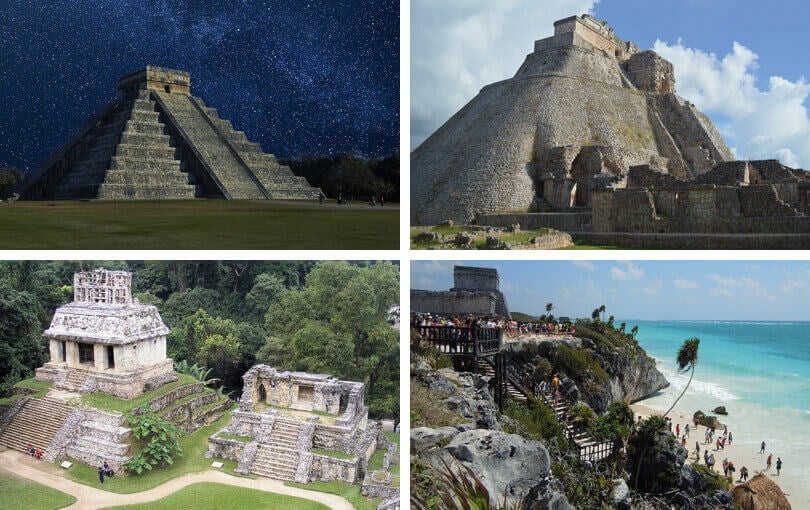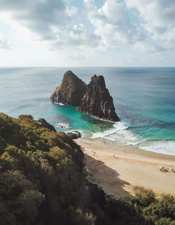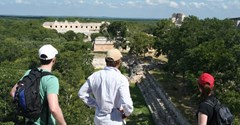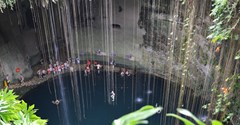In the first of the series, we delve into the past to discover the ancient civilisations of Latin America, starting with the mighty Mayans.
Latin America's ancient civilisations: the Mayans
The well-preserved archaeological sites of ancient Pre-Columbian civilisations have allowed experts to piece together what life was like in Latin America, all those centuries ago. When overlaid by the sweeping cultural and architectural changes brought forth by European colonisers in the 16th century, this blend provides a platform on which our expert local guides can lead you on a panoramic journey through history, which spans millennia.
Better yet, most ruins are found in extraordinary landscapes; Andean mountains, tropical jungle, Caribbean beaches or vast desert and are accessed from nearby cities in which we can experience modern local life and discover which ancient traditions and customs continue to thrive today.
We start our series of articles about the most preeminent ancient cultures and civilisations from Latin America with the mighty Mayans of Central America.
Getting to know the Mayans
Where: The Mesoamerican Maya empire stretched across Mexico's Yucatan Peninsula and into the neighbouring states of Chiapas and Tabasco, down into Guatemala, Honduras and Belize. Their cities were usually set within deep jungle, many within reach of a nearby cenote (a limestone sinkhole that was a natural source of rainwater). At its peak, the empire was thought to be some 13 million strong.
When: The empire spanned over 3,000 years, from 1800 BC to the 16th century AD. It reached its zenith, known as the Classical Period, between 250 and 900 AD, though continued strong in Mexico until the arrival of Spanish conquistadors in the 1500s.
Key figures: The Maya empire revolved around a pantheon of deities; a huge variety of gods and goddesses which encompassed the sun, rain, war and the underworld, through to more obscure themes such as bees, fishermen and even suicide and homosexuality. The civilisation was run by a series of godlike kings, who built immense temples and pyramids to demonstrate their unquestionable power.
Characteristics: As well as constructing some of the most impressive and sophisticated ancient structures in Latin America, the Mayans were renowned for their advance knowledge in other areas, including mathematics, art, writing and cosmology. They also are credited with developing a complex 365 day calendar system and various ritual ball games. The empire grew from an agricultural base and this provided the backbone for its expansion, with many workers tending the land surrounding the biggest cities.
Heritage: The might of the Mayan empire is best evidenced in their stone cities, which were built deep in rainforest around towering pyramids, vast ball courts and magnificent temples, many of which have survived the test of time (and the best efforts of the conquistadors to demolish them). The most well-known and impressive of these are Chichen Itza and Uxmal in Mexico's Yucatan Peninsula and Palenque in the state of Chiapas. Outside of Mexico, Tikal and Ceibal in Guatemala, Lamanai in Belize and Copan in Honduras are the most renowned. However, there are many other smaller and lesser-visited Mayan archaeological sites, particularly in Campeche in the Yucatan and in the south of Guatemala. The hilltop ruins of Tulum overlook an idyllic beach on Mexico's Riviera Maya.
Many sites are close to sacred underground cenotes and visitors can bathe in a number of these. Within the sites it is possible to appreciate not just the scale of the structures, but also their elaborate and intricate decoration and relive, through an expert guide, what life would have been like as part of the ancient Mayan society. Around 70 dialects of Mayan languages are thought to still be spoken in Central America.
Downfall: The sharp decline of the Mayan empire in the eighth to tenth century is a source of enduring mystery, as huge cities begun to be abandoned and gradually swallowed up by the jungle. War, drought, over-population and even climate change have all been mooted as possible causes or contributory factors. The definitive end to the empire can be traced to the arrival of Spanish invaders in the sixteenth century, bringing to an end the thriving cities of Chichen Itza, Uxmal and a few others.
Suggested tour: Visit Mexico and Guatemala's biggest Mayan sites on our 15 night Pacal tour, from £4,346 per person.
 Chichen Itza, Uxmal, Palenque & Tulum in Mexico
Chichen Itza, Uxmal, Palenque & Tulum in Mexico
Sources: history.com & ancient.eu
Choose your perfect holiday
Find inspiration from our selection of itinerary suggestions, a great starting point for your next trip
View More Tours
Stay in touch
Infuse your travels, with inspiration from our monthly newsletter.
READY - 20 April 2024
LANDMARK TOURS: Multi-Country & Cross Continent. New Cosmopolitan Tour: Buenos Aires, Iguazu, Rio
CHINA & INDIA: Local Life, People & Unique Cultures
GUIDES by Veloso Tours, are the best Local Hosts
PRIVATE VILLAS: Quality Time in exclusive settings
TRAVEL INSURANCE with extensive COVID-19 cover





